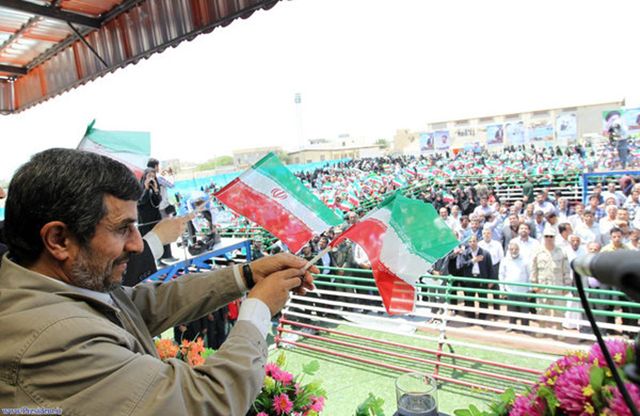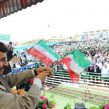
Low Level Boundary Dispute Intensifies as Iran and the UAE Contest Control of Strategic Gulf Islands
Publication: Terrorism Monitor Volume: 10 Issue: 9
By:

The April 22 visit of Iranian president Mahmoud Ahmadinejad to the Island of Abu Musa near the mouth of the Strait of Hormuz has triggered new tensions between Iran and the United Arab Emirates (UAE) (al-Jazeera, April 16; Gulf News April 16). The decades-long territorial dispute over the islands of Abu Musa and the Greater and Lesser Tunbs has been a contentious issue between the two countries since 1971, when the military forces of Mohammad Reza Shah Pahlavi occupied the islands on the eve of the formation of the UAE.
The UAE condemned Ahmadinejad’s visit as “provocative” and recalled its ambassador to Iran after what it described as “a flagrant violation” of its territorial sovereignty (Emirates News Agency, April 13; The National [Abu Dhabi], April 13; Radio Zamaneh [Amsterdam], April 17). As the United States called on Iran to enter negotiations with the UAE, Tehran summoned the Swiss Ambassador (who acts as an intermediary in the absence of diplomatic relations between the United States and Iran) to protest Washington’s position over the disputed islands. Iran maintains it has valid and indisputable historical claims to the islands and has accordingly suggested that talks with the UAE are needed only to clear up “misunderstandings” (Tehran Times, April 20).
In response to a Gulf Cooperation Council (GCC) statement offering full support to the UAE in the event of foreign “aggression” in the Gulf, General Ahmad Reza Pourdastan, the commander of Iranian ground forces, announced on April 19 that Iran “will not allow any country to carry out an invasion. If these disturbances are not solved through diplomacy, the military forces are ready to show the power of Iran to the offender” (al-Arabiya, April 20).
The latest Iran-UAE conflict over the islands is, however, less about territorial disputes and more an attempt by Iran to exert power at a time when U.S.-led sanctions and domestic problems are posing difficulties for the stability of the regime. The key point of contention is the extent to which Iran can maintain its sphere of military influence over the Strait of Hormuz as a critical strategic location for containing U.S. and Israeli military threats. Fully aware that the UAE will not engage in a military defense of their claim, Tehran’s willingness to flex its muscles over the disputed islands is by and large meant to send a clear signal to its adversaries that it can resort to military action in the event of an attack against its nuclear sites (Zamaneh Radio, April 19).
Both Iran and UAE claim historical sovereignty over the islands. From the Emirates’ point of view, the islands have belonged to the Qasim tribe since the 18th century, when Arab commercial activities extended to both the northern Iranian and southern Arabian shores of the Gulf. After 1750, the Qasimi rulers of the Sharjah and Ras al-Khameh Emirates maintained control over the islands from Lengheh (a nearby port in modern Iran that was controlled at the time by Arabs from the coastal city of al-Khobar in the Arabian Peninsula) and the city of Sharjah (based in today’s UAE) (Gulf News, April 25). There is no evidence Iran ever controlled the islands before 1904, when, according to the Sharjah Emirate, the Iranian Qajar dynasty (1785-1925) challenged Sharjah’s sovereignty over the islands by attempting to invade them. The British recognized Arab sovereignty over the islands as early as 1820, when they began to get involved in the Persian Gulf. After a British takeover of the islands in 1921, their Arab ownership continued to be recognized by London by making Sharjah Emirate the administrative authority in the islands. The Emirates describe several Iranian attempts to take over the islands in the early 20th century as illegal and insist that Arab sovereignty was inherited by the UAE with its formation in 1971.
From Iran’s point of view, the 1971 takeover of Abu Musa by the Pahlavi military just 20 hours after the departure of British troops in accordance with the end of the British Treaty of Protection and the federation of the seven Emirates into the UAE was justified in light of Iranian historical claims over the islands. According to Iran, the 1971 joint administrative agreement between Iran and Sharja, defined in terms of joint ownership of the territories with an Iranian military presence on the islands, was largely the product of British involvement in the negotiation process, with London still recognizing Arab rights to the islands. [2] In reality, Iranians argue, the islands of Abu Musa and the Greater and Lesser Tunbs have belonged to Persia since pre-Islamic times. While Iranians recognize that the Arab Qasim tribe ruled over the islands in the 18th century, they maintain the Qasimis did so from the Iranian port of Lengheh under the authority of the Persian Qajar dynasty. The UAE, therefore, has no justified historical claim to the islands. In fact, the takeover of the islands by Iran was primarily an attempt to end British colonial rule over Iranian territories and was not intended to stir hostility against the Arab Emirates, though the 1971 Iranian occupation was met with resistance that resulted in the death of several Iranian soldiers. [2]. The latest calls by the Iranian parliament to make Abu Musa an independent province and develop it as a tourist destination are ultimately the extension of Iran’s claims to historical sovereignty (Fars News April 17).
The three disputed islands, however, have remained integral to the nationalist discourses of the two nations, with neither side willing to compromise over joint control of the islands. This has left little room for progress on power sharing and, more importantly, resolving potential military confrontations between the two countries, especially with increased Iranian military activity in the Persian Gulf.
Beyond the historical tensions, there are three important political realities behind Ahmadinejad’s visit to the island of Abu Musa:
- Amid the ongoing nuclear negotiations, Tehran appears to be sending a clear message to Washington that it still considers the Strait of Hormuz a potential site for launching attacks against oil shipments in the event of U.S. participation in a military attack. The three islands are in a strategic location where the depth of the water between the islands provides a passageway for tankers and other commercial ships to reach the Strait of Hormuz.
- In light of the recent increase in tensions between Iran and Saudi Arabia, Tehran seems to be warning the GCC and especially the UAE of the consequences of their participation in U.S.-led sanctions and possible collaboration with the United States in the case of a military attack. While Iran knows that the UAE will refrain from engaging in any military retaliation to its occupation of the Gulf islands, the latest provocative moves by Iran serve to remind the Persian Gulf states that Iran still maintains regional ambitions and a will to defend its perceived sphere of influence against its regional adversaries.
- Most importantly, Ahmadinejad’s visit to Abu Musa could also reflect an ongoing factional divide between Iran’s Supreme Leader, Ayatollah Ali Khamenei, and the Iranian president, a conflict that resulted in the defeat of Ahmadinejad and his followers at the hands of the Supreme Leader’s supporters in the March 2012 parliamentary elections. Since spring 2011, Ahmadinejad has attempted to defy the authority of the Supreme Leader on key issues related to governance and especially management over various state agencies. While the tensions have subsided considerably in recent months, Ahmadinejad has sought to demonstrate his strength at various critical moments in order to remind the conservative political establishment of his ability to influence Iranian domestic politics. The President’s visit to the island, the first ever by a president in the history of the Islamic Republic, is a clear attempt to boost nationalist sentiments and bolster popular support for a faction that is seeking to find a place in Iranian politics after the end of Ahmadinejad’s second presidential term in 2013.
Nima Adelkhah is an independent analyst based in New York. His current research agenda includes the Middle East, military strategy and technology, and nulcear proliferation among other defense and security issues.
Note:
1. Richard A.Mobley, “The Tunbs and Abu Musa Islands: Britain’s Perspective,” Middle East Journal 57(4), 2003, pp. 627-645
2. R.P. Owen, “The British Withdrawal from the Persian Gulf,” The World Today, 28(2), 1972, pp. 75-81.
3. Ibid, p.78.




